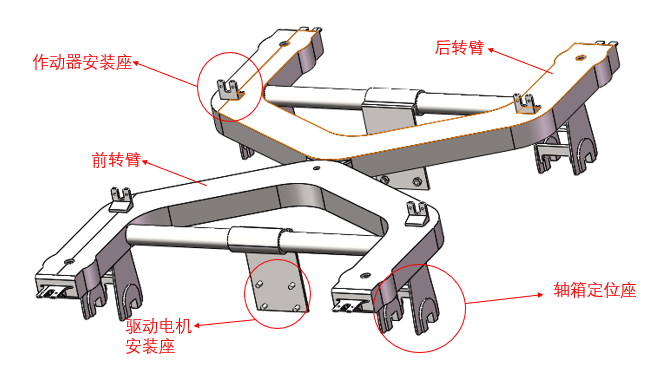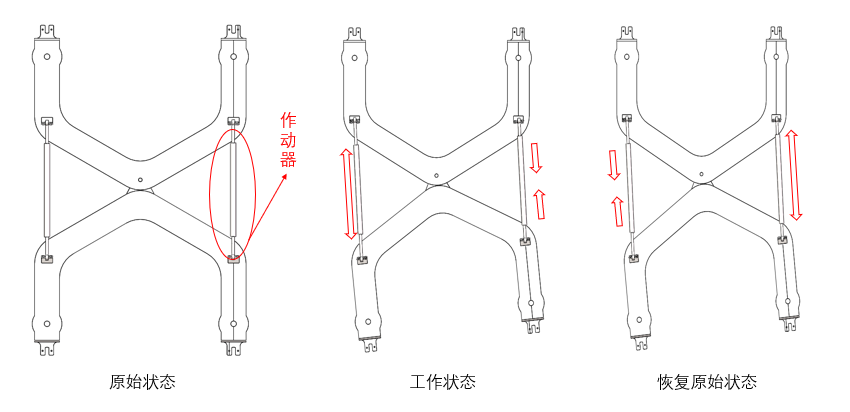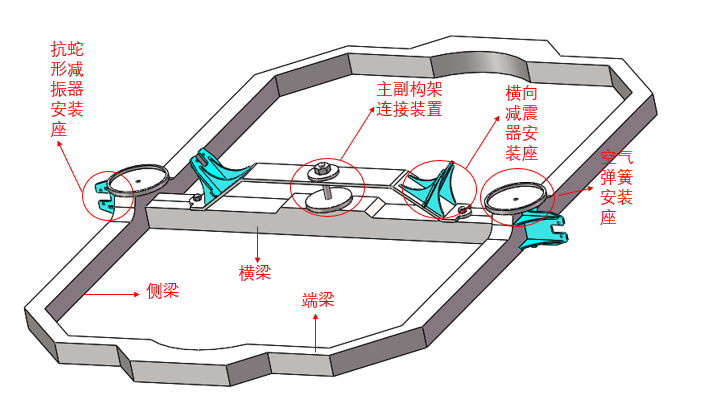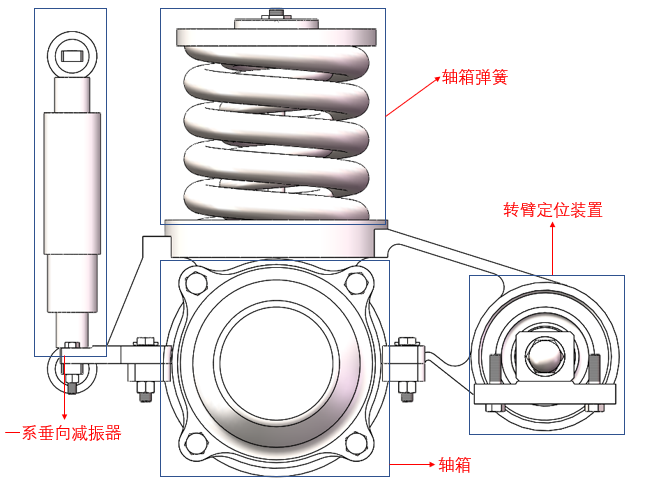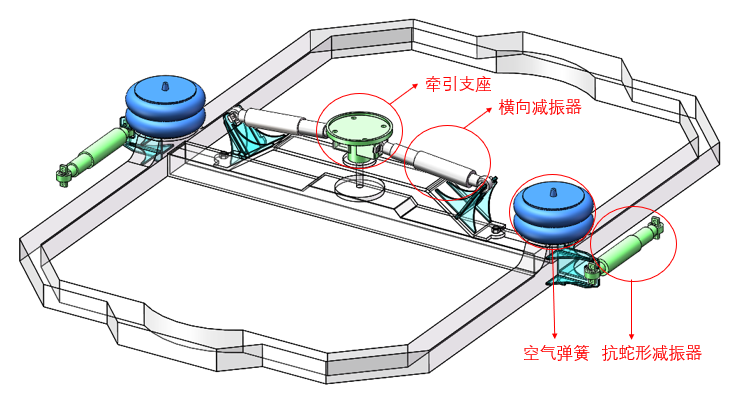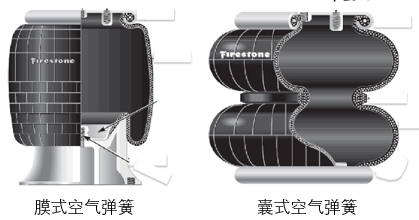主动径向转向架概念设计及轮对磨耗机理分析研究毕业论文
2020-02-17 12:48:37
摘 要
轨道车辆在行驶的过程中,轮对与轨道之间会发生一定的相对滑动,尤其是在曲线行驶中显得尤为明显,这种现象被称为轮对的蠕滑现象。随着科技技术的不断发展,现代的轨道车辆无论是干线铁路还是地铁线路其运行速度都在不断地提升,负载重量也得到了提高,此外,现代的高速轨道车辆为了获得一定的稳定性,通常会伴随着较差的弯道通过性能,这一系列的问题都会造成轮对与轨道之间的蠕滑力过大。当蠕滑力过大时会导致轮对磨耗过度,缩短转向架的使用寿命,造成大量的能量浪费与环境污染的同时还会增加铁路运输成本,影响铁路的正常运输。
本论文设计了一种能够主动径向转向的转向架,通过主动控制转向架的前后轮对偏转实现主动径向转向,以此来改善列车曲线通过性能,降低轮对的磨耗,提高车辆过弯安全性。本文通过SOLIDWORKS建模软件对转向架整体进行建模,采用SIMPACK内置控制单元对主动径向转向架的动力学性能进行建模仿真研究,并分析了轮对磨耗发生机理,将主动径向转向架同传统转向架的磨耗进行对比研究。具体的研究工作如下:
1、主动径向转向架概念设计。首先对主动径向转向机理进行了分析,随后介绍了转向架SOLIDWORKS模型的构成及各部分的作用,主要包括有主副构架结构、一系悬挂装置、二系悬挂装置以及一些其他的附加装置。
2、主动径向转向架的动力学模型建立。建立了主动径向转向架列车与传统转向架列车的SIMPACK整车仿真模型,为后续章节奠定基础。
3、主动径向转向架动力学性能分析。对装配了主动径向转向架的列车进行了直线运行稳定性仿真,仿真结果表明列车的直线运行速度达到290km/h列车才会出现蛇形运动,能满足实际工程需求。对列车的直线运行平稳性进行了仿真,结果表明横向及垂向平稳性均处于“好”—“可以运行”之间,平稳性能良好。同时还仿真分析了列车的曲线通过性能,结果表明当列车的过弯速度≤70km/h时,内外轨的脱轨系数均小于0.6,达到了优秀评级。
4、主动径向转向架与传统转向架轮轨磨耗对比分析。首先对列车的磨耗机理进行了介绍,并选取了相应的滚动接触理论以及磨耗评价指数。随后仿真分析了三种速度下的主动径向转向架列车与传统转向架列车的磨耗指数Wear Number,结果表明无论在什么速度下,主动径向转向架的过弯磨耗量均要比传统转向架小很多。最后将三种速度下的主动径向转向架冲击轮对车轮进行对比,结果表明70km/h时是主动转向架的最佳过弯速度,这时其车轮综合磨耗最小。
关键词:主动径向转向;传统转向架;SIMAPCK仿真;磨耗对比分析
Abstract
In the running process of rail vehicles, relative slip will occur between wheelset and track, especially in curvilinear running. This phenomenon is known as the creep phenomenon of wheelset. With the continuous development of science and technology, the running speed of the modern railway vehicles trunk railway lines and subway lines is in constant increase, the load weight is improved, moreover, the modern high-speed railway vehicles in order to obtain a certain stability, often accompanied by poor performance through corners through the, this series of problems will cause excessive creep force between wheel and track. When the creep force is too large, it will cause excessive abrasion of wheelset, shorten the service life of bogie, cause a lot of energy waste and environmental pollution, and at the same time increase the cost of railway transportation and affect the normal railway transportation.
This paper designs a kind of bogie capable of active radial steering, which can achieve active radial steering by actively controlling the deflection of the front and rear wheelsets of the bogie, so as to improve the passing performance of train curves, reduce the wear of wheelsets and improve the safety of vehicle bending. In this paper, the whole bogie is modeled with SOLIDWORKS modeling software, and the dynamic performance of the active radial bogie is modeled and simulated with the built-in control unit of SIMPACK, the mechanism of wheel set abrasion is analyzed, and the abrasion of the active radial bogie is compared with the traditional bogie. Specific research work is as follows:
1. Concept design of active radial bogie. Firstly, the mechanism of active radial steering is analyzed, and then the SOLIDWORKS model of bogie and the functions of each part are introduced.
2. Establishment of dynamic model of active radial bogie. The SIMPACK vehicle simulation model of active radial bogie train and traditional bogie train is established, which lays a foundation for the following chapters.
3. Dynamic performance analysis of active radial bogie. The linear running stability simulation of the train equipped with active radial bogie is carried out, and the simulation results show that only when the maximum linear running speed of the train reaches 290km/h will the train have snaking movement, which can meet the actual engineering requirements. The simulation results show that the horizontal and vertical stationarity are between "good" and "runnable", and the stationarity is good. At the same time, the curve passing performance of the train is simulated and analyzed. The results show that when the bending speed of the train is less than 70km/h, the derailment coefficient of the inner and outer rails is less than 0.6, reaching the excellent rating.
4. Comparative analysis of wheel and rail abrasion between active radial bogie and traditional bogie. Firstly, the wear mechanism of the train is introduced, and the rolling contact theory and wear evaluation index are selected. Then, the Wear index Wear Number of the active radial bogie train and the traditional bogie train under the three speeds was simulated and analyzed. The results showed that the bending Wear of the active radial bogie was much smaller than that of the traditional bogie at any speed. Finally, a comparison is made among the wheels of the active radial bogie at three speeds. The results show that the best bending speed of the active bogie is 70km/h, and the comprehensive wear of each wheel is the minimum.
Keywords: active radial steering; Traditional bogie; SIMAPCK simulation; Comparative analysis of abrasion
目 录
第1章 绪论 1
1.1研究背景与意义 1
1.2 国内外径向转向架的发展过程 2
1.2.1径向转向架的概念 2
1.2.2国内外径向转向架的发展 3
1.3国内外研究现状 5
1.3.1径向转向架 5
1.3.2轮对磨耗 6
1.4本文主要研究工作 7
第2章 主动径向转向架模型设计 8
2.1主动径向转向架原理 8
2.2径向转向架整体布局设计 8
2.3主动径向转向架主要构件 9
2.3.1主构架 9
2.3.2副构架 10
2.3.3一系悬挂装置 11
2.3.4二系悬挂装置 12
2.3.5其他装置 14
2.4传统转向架与主动径向转向架对比 16
2.5本章小结 17
第3章 基于SIMAPACK的整车动力学仿真模型构建 18
3.1车辆动力学研究内容 18
3.1.1车辆运行稳定性 18
3.1.2车辆运行平稳性 19
3.1.3车辆曲线通过性 20
3.2仿真软件介绍 21
3.3整车仿真模型 21
3.4 本章小结 25
第4章 转向架动力学性能分析 26
4.1运行稳定性 26
4.2运行平稳性 27
4.3曲线通过性能 30
4.4本章小结 33
第5章 磨耗分析 34
5.1 磨耗机理 34
5.2 传统转向架与主动径向转向架磨耗对比 36
5.3主动径向转向架最佳过弯速度 38
5.4本章小结 40
第6章 结论 41
6.1 研究总结 41
6.2 研究展望 42
参考文献 43
致 谢 45
第1章 绪论
1.1研究背景与意义
伴随着国家不同层面的全方位发展,铁路交通也在顺应时代的潮流不断地自我更新发展,逐渐形成了以下的几个特点:运输范围广,运行能力强,综合运输成本低,能耗率低等等,已经逐步成为了我国乃至世界交通运输业中的中流砥柱,在世界交通运输的领域中承载着重要的作用。
同时,铁路建设作为一项推动民生经济大力发展的基础建设,在国家经济体制中扮演着举足轻重的作用,是我国大交通网络中的基础与重要组成部分之一。我国的人口特点体现在人口基数大、集中程度高,同时各省市地区之间的经济发展差异较大,这一系列的现象决定了大运量、长距离的客运需求将会长期存在。据统计,2018年全国一共有2.44亿的人口流动量,这一数值大约是全国总人口的17.5%,尽管如今人口流动量呈现一个下降的趋势,但是在未来很长的一段时间范围内,人口流动量仍然会占据着总人口的很大一部分比例,经济落后区域如农村区域及中西部地区的人口仍然会向着城镇及经济发达区域转移,旅客运输量将会常年保持在一定的基数之上。除了客运以外,货物运输方面的铁路需求也在一定程度上推动着我国铁路的发展,由于我国的自然资源分布情况差别较大,中西部地区地域辽阔、人口稀少,而煤炭保有量却是全国总煤炭量的92.2%,东部只占了7.8%的比例,但是工业发展情况却又相反,这种资源与工业极不合理的分布情况要求了大量的能源资源需要不断的进行运输,同时为了能够保障中西部地区人民的生活物质需求,大量的加工商品又需要不断地被运往中西部地区,这种现象对我国铁路情况提出了更高的要求。
相关的分析报告显示,自2009年起,我国的铁路建设便进入了一个突飞猛进的发展阶段,2010年,我国对交通基础建设共投资了约2万亿元。至2010年底,全国共有9.1万公里长的运营铁路线路,排在了世界的第二位。2008年,国务院对《中长期铁路网规划》文件进行了调整,指出在原有的 “四横四纵”铁路线路要求之上,充分利用现有铁路并对其进行高速化改造,争取形成“八横八纵”的主要骨架,到2020年全国的铁路运营总长度争取突破12万公里,将复线率以及电化率提高至50%以及60% [1]。根据2015年发布的《铁路“十二五”发展规划》显示在该年我国的铁路营业总里程便已经达到了12万公里的要求,基本建成了总长4万公里的快速铁路网,复线率以及电化率的要求也已实现,将原本计划至2020年实现的目标提前了5年。在铁路线路基础建设大力发展的同时,也对提高运输质量以及客运能力提出了相应的要求,对此我国对铁路旅客列车进行了6次大提速以此来适应市场需求,提高运输服务质量的体现。
目前我国对于铁路高速化投入了大量的精力与财力,铁路高速化的实现方式主要有两点:(1)通过建设大规模的高速铁路线路,实现列车运行速度达到250km/h以上,该线路的曲线半径一般不小于4000m,主要运行有和谐号与复兴号等高速列车,这一举措能够有效地提高列车的输送效率,给旅客带来出行便利。(2)改造现有的一些旧式线路使其满足高速化运营要求[2]。但是由于我国地域辽阔并且全国铁路网总长度长,需要投入大量的财力、物力与人力,较难实现整体改造。在这种情况之下,便需要对现有的列车进行性能上的改进,其中的一种方法便是对列车的转向架进行改造。由于既有的不少线路都存在着曲线半径小且曲线部分多的特点,而曲线半径的大小是影响列车运行品质的关键因素之一。为了能够适应不同的曲线半径,人们发明了径向转向架,该转向架能够使轮对在转弯的过程中保持轮轴处于曲线径向上,以此来提高列车过弯运行品质。
而本论文的研究对象主动径向转向架便是径向转向架中的一种,其能够进一步提高小半径曲线的转向性能,不同于其他的径向转向架,该转向架主要通过安装在前后转臂之间的作动器来推动轮对转动,从而实现轮对径向的目的。同时在直线运行时,不运作的作动器还能给轮对提供一定的纵向定位刚度,提高运行稳定性。
以上是毕业论文大纲或资料介绍,该课题完整毕业论文、开题报告、任务书、程序设计、图纸设计等资料请添加微信获取,微信号:bysjorg。
相关图片展示:
